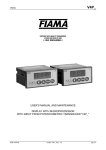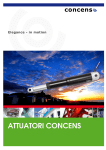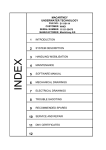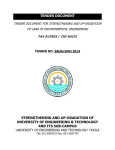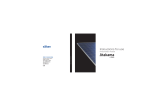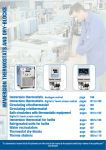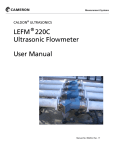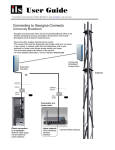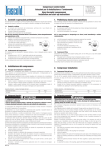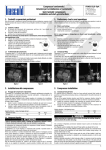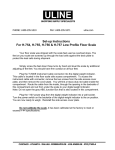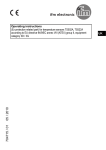Download "BP" SERIES WEIGHING BARS
Transcript
"BP" SERIES WEIGHING BARS Installation and user instructions Ver. 10.06 INDEX IMPORTANT WARNINGS ......................................................................................................................................................3 1. INTRODUCTION.................................................................................................................................................................3 1.1 MAIN TECHNICAL FEATURES.....................................................................................................................................4 2. INSTALLATION ..................................................................................................................................................................4 2.1 INSTALLATION OF BPSI, BPM, AND BPX BARS ........................................................................................................4 2.2 INSTALLATION OF BPL BARS.....................................................................................................................................6 2.3 EXAMPLE OF INSTALLATION......................................................................................................................................7 3. MAINTENANCE AND REPAIRS ........................................................................................................................................8 3.1 TO OBTAIN THE BEST PERFORMANCES..................................................................................................................8 3.2 DAMAGES AND OVERLOADS .....................................................................................................................................8 4. TRANSPORT OF THE WEIGHING BARS..........................................................................................................................8 5. TABLE WITH CAPACITIES AND SIZES............................................................................................................................8 6. DIMENSIONS AND PUNCTURE HOLE AREAS OF THE BPSI BARS .............................................................................9 7. DIMENSIONS AND PUNCTURE HOLE AREAS OF THE BPM,BPX BARS ...................................................................10 8. DIMENSIONS AND PUNCTURE HOLE AREAS FOR BPL BARS ..................................................................................11 9. EQUALISATION AND CALIBRATION INSTRUCTIONS OF A WEIGHING BAR SYSTEM (FIG.3)................................12 10. SHIELDED CONNECTION CABLE BETWEEN THE JUNCTION BOX (JBOX) AND INDICATOR...............................13 WARRANTY .........................................................................................................................................................................14 2 IMPORTANT WARNINGS Do not solder, puncture or modify the structure without consulting the seller. Eventual damages or tamperings void the warranty conditions. Do not tread, trample or expose the shielded connection cable to heat sources. If material is weighed, whose manipulation can cause electrostatic discharges (powders, plastic materials, etc.). ONE MUST GROUND the metallic structure of the weighing bars using one of the fixing holes. If there are doubts consult the reseller. If the place of use is a damp or wet environment, the installation must be made in order to avoid accumulations or water stagnations and/or debris under the structure. DO NOT INSTALL IN A HAZARDOUS ENVIRONMENT. (unless it is specifically provided for) Do not use solvents for its cleaning. 1. INTRODUCTION All the weighing modules are built with quality materials and with a calibration procedure which guarantees the maximum reliability and weighing precision in time. The BP series’ weighing bars are suitable for weighing rigid structures (hoppers, conveyor belts, roller units, pallets, tanks, cases, etc...), systems for weighing small, medium and large capacity objects; the weight capacities vary from a minimum of 15 kg up to 6000 kg. The measuring elements are made of load cells made according to the standards required by the OIML R60 International Recommendation. The BPL bars are fitted with 4 stainless steel SHEAR-BEAM load cells, resistant to dust and humidity according to IP68 norms. The BPSI, BPM and BPX weighing bars are fitted with 2 aluminum OFF-CENTER load cells, resistant to dust and humidity according to IP67 norms. All the modules are designed and built with a large load safety margin which guarantees its functioning also in particularly adverse conditions. 3 1.1 MAIN TECHNICAL FEATURES - Functioning with 4 approved shear-beam load cells in IP68 stainless steel (BPL) and with 2 off-center approved load cells in aluminum (BPSI-BPM-BPX), according to the OIML R60 norms with protection from dust and humidity according to IP67 norms (350 Ohm input resistance) - Structure made with profiles and oven-painted carbon steel plate and complete of fitted with articulated joints for compensating the bending and/or expansion of the structure to be weighed, and with stops for protection from accidental bumps. - Screened 3m long 4-pin cable for connecting each bar with the fitted junction box. - Up to 15 Vdc power supply. - IP67 hermetic equalized junction box with screened 5m long 6-pin cable with connectors for connection to the indicator - The STAINLESS STEEL model has the structure, mechanics, and trinkets in AISI304. 2. INSTALLATION The accuracy of the weighing system depends on the following prerequisites: 1) Environment and mechanics appropriate for weighing: rigid, planar and exempt from vibrations 2) Weighing bars directly connected to the system (see the “EXAMPLE OF INSTALLATION” and “EQUALISATION AND CALIBRATION INSTRUCTIONS OF A WEIGHING BAR SYSTEM” chapter) 3) Barycentre of the loading and unloading system inside the bars and weighing made within the two bars 4) Time period of weight reading enough to stabilize it. 2.1 INSTALLATION OF BPSI, BPM, AND BPX BARS NOTE: The weighing bars must be connected to the weight indicator through its cable coming from the junction box following the instructions in the indicator manual. The electronic instruments connected to the weighing bars can not be calibrated before being powered. The customer is responsible for preparing and calibrating the instrument. For further details refer to the technical operating manual of the instrument. A) After having removed the eventual packing, UNBLOCK THE WEIGHING BARS (only for BPM and BPX, while the BPS bars are not blocked) BY UNSCREWING AND REMOVING THE “A” SCREWS, REF. FIGURE 1. B) Adjust the weighing bars so that these lie flat. C) Connect the shielded cable coming from the junction box to the weight indicator, refering to the instructions of the indicator itself. The cable must be free and not provoke resistance so that it does not influence the measurement. D) Carry out the equalization of the bars, see the relative paragraph. E) Carry out the calibration and SetUp of the indicator as shown on its user manual. F) If it will be moved again, remember to block the bars by screwing the A screws, figure 1. G) RESPECT AND APPLY THE WARNINGS OF PAGE 2 4 BPM, BPX BARS A A BLOCKED BAR UNBLOCKED BAR FIG.1 5 2.2 INSTALLATION OF BPL BARS NOTE: The weighing bars must be connected to the weight indicator through its cable coming from the junction box following the instructions in the indicator manual. The electronic instruments connected to the weighing bars can not be calibrated before being powered. The customer is responsible for preparing and calibrating the instrument. For further details refer to the technical operating manual of the instrument. A) After having removed the eventual packing, UNBLOCK THE WEIGHING BARS BY UNSCREWING AND REMOVING THE SCREWS, REF. FIGURE 2. B) Do not remove for ANY REASON the bolts and the painted RED screws. C) Adjust the weighing bars so that these lie flat. D) Connect the shielded cable coming from the junction box to the weight indicator, refering to the instructions of the indicator itself. The cable must be free and not provoke resistance so that it does not influence the measurement. E) Carry out the equalization of the bars, see the relative paragraph. F) Carry out the calibration and SetUp of the indicator as shown on its user manual. G) If it will be moved again, remember to block the bars by screwing the A screws, figure 1. H) RESPECT AND APPLY THE WARNINGS OF PAGE 2 . BPL BARS YELLOW RED FIG.2 RED= SCREWS NOT TO BE MOVED OR ALTERED FOR ANY REASON YELLOW= SCREW TO BE REMOVED IN ORDER TO UNBLOCK THE WEIGHING BAR 6 2.3 EXAMPLE OF INSTALLATION CORRECT INSTALLATION: WEIGHING DIRECTION ROLLER WEIGHING BARS WRONG INSTALLATION: WEIGHING DIRECTION ROLLER WEIGHING BARS 7 3. MAINTENANCE AND REPAIRS 3.1 TO OBTAIN THE BEST PERFORMANCES - Keep the weighing bars clean. If dirt and powder accumulate on the weighing bars, clean them with a damp cloth or with the standard cleaning products (do not use SOLVENTS and ACIDS). - Avoid that the weighing bars be subject to knocks, otherwise serious damages take place. 3.2 DAMAGES AND OVERLOADS If you think that the weighing bars are broken or damaged, disconnect these in a permanent manner. Do this, if the weighing bars: - show damage signs. - cease to function. - have been overloaded beyond the tolerable limits (for example during the transport, or while being stocked). 4. TRANSPORT OF THE WEIGHING BARS To pack the weighing bars follow the procedures below: a) turn off the instrument. b) Disconnect the instrument from the weighing bars 5. TABLE WITH CAPACITIES AND SIZES DIMENSIONS mm BAR MODELS CAPACITY Max. kg HEIGHT RESTING SURFACE BPSI 15 / 30 / 60 / 150 85+20 400 x 80 BPM 60 / 150 / 300 130 600 x 105 BPX 150 / 300 / 600 130 800 x 135 BPL 600 / 1500 / 3000 / 6000 120 1200 x 150 8 6. DIMENSIONS AND PUNCTURE HOLE AREAS OF THE BPSI BARS M6 9 10 ZONES IN WHICH ONE CAN DRILL A HOLE ZONES IN WHICH ONE MUST NOT DRILL A HOLE 7. DIMENSIONS AND PUNCTURE HOLE AREAS OF THE BPM,BPX BARS BLOCKING SCREWS FOR TRANSPORTATION 8. DIMENSIONS AND PUNCTURE HOLE AREAS FOR BPL BARS 11 ZONES IN WHICH ONE CAN DRILL A HOLE ZONES IN WHICH ONE MUST NOT DRILL A HOLE 9. EQUALISATION AND CALIBRATION INSTRUCTIONS OF A WEIGHING BAR SYSTEM (FIG.3) 1 Screw (turning clockwise) the screws of all the T trimmers, in order to have the maximum signal on all the cells. 2 Carry out the calibration putting the weight in the center, with a weight of about 1/3 of the capacity. 3 Put the sample weight on the 4 angles (1, 2, 3, 4) in the same manner and locate the cell which has the lowest displayed weight. 4 Adjust the remaining 3 cells so that the these have the weight equal to the cell with the lowest signal; do this by: A. Positioning the sample weight on the angle corresponding to the cell with the greatest weight. B. Unscrewing (turning counterclockwise) the screw of the T trimmer of the corresponding cell until you have a weight value equal to that of the cell with the lower weight value. C. Repeating actions “A” and “B” for the remaining two angles. 5 Check again that all four angles indicate the same weight value. Otherwise, repeat points 3 and 4. If so, carry out again the calibration and put the weight in the center. N.B. For a good outcome of the equalization of the system one should use a sample weight of small dimensions, about 1/3 of the scale capacity, so that the load is concentrated on each single cell. WEIGHING BARS CALIBRATION WEIGHT ROLLER UNIT (example) CALIBRATION WEIGHT FIG.3 12 NOTES: Adjust the weighing bars so that these lie flat. Wire the eventual other cables (motors, photo cells, etc.) connected to the roller unit (for example) in order to have horizontal stretches which don’t produce friction which could influence and not make the weigh repeatable WRONG WIRING CORRECT WIRING FLAT POSITIONING OF THE BARS 10. SHIELDED CONNECTION CABLE BETWEEN THE JUNCTION BOX (JBOX) AND INDICATOR INPUT + SENSE + INPUT SENSE OUTPUT + OUTPUT SHEATHING Brown Green Grey White Pink Yellow Orange 13 WARRANTY The TWO YEARS warranty period begins on the day the instrument is delivered. It includes spare parts and labour repair at no charge if the INSTRUMENT IS RETURNED prepaid to the DEALER’S PLACE OF BUSINESS. Warranty covers all defects NOT attributable to the Customer (such as improper use) and NOT caused during transport. If on site service is requested (or necessary), for any reason, where the instrument is used, the Customer will pay for all of the service technician’s costs: travel time and expenses plus room and board (if any). the Customer pays for the transport costs (both ways), if the instrument is shipped to DEALER or manufacturer for repair. The WARRANTY is VOIDED if any of the following occurs: repairs or attempted repairs are made by unauthorized personnel, connected to equipment installed by others, or is incorrectly connected to the power supply, or instrument has defects or damage due to carelessness or failure to follow the guidelines in this instruction manual. This warranty DOES NOT provide for any compensation for losses or damages incurred by the Customer due to complete or partial failure of instruments, even during the warranty period. AUTHORIZED SERVICE CENTRE STAMP 14














![ACTIVALL - Instrukcja Obsługi_EN [w5] - Akces](http://vs1.manualzilla.com/store/data/005768844_1-d053a11c07508a5544c783645c43d650-150x150.png)
